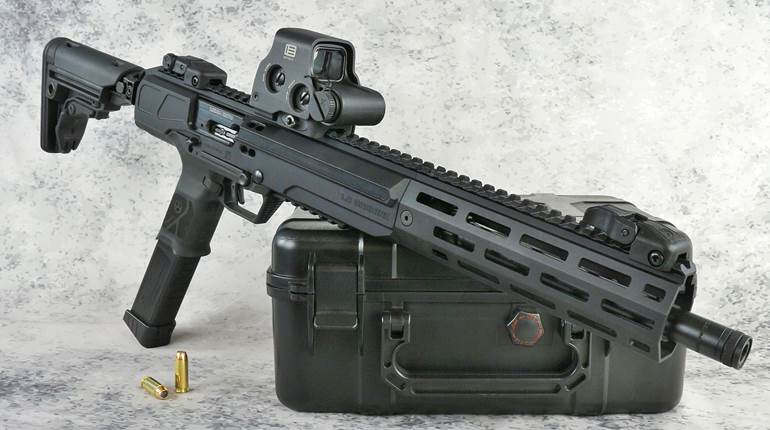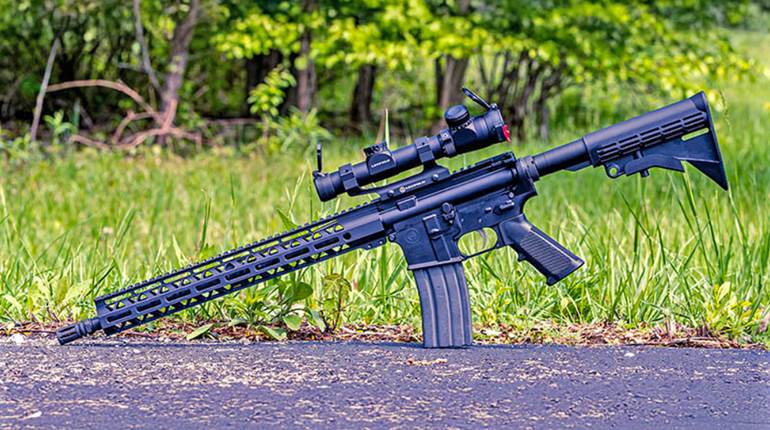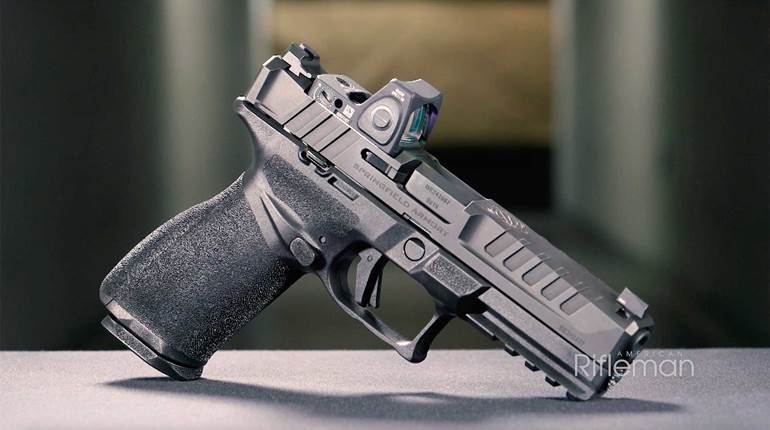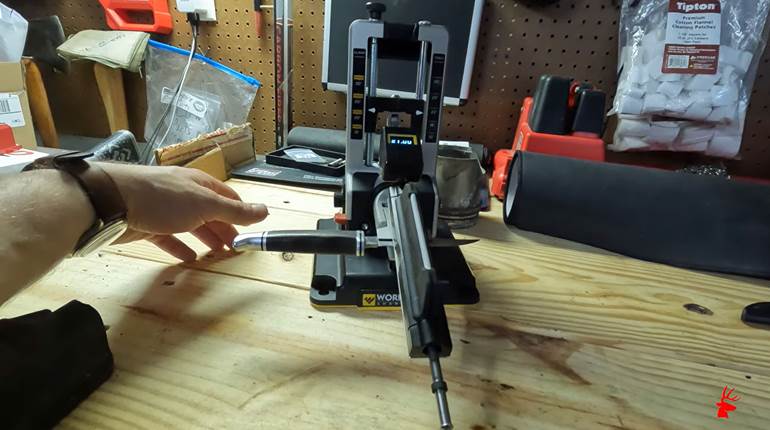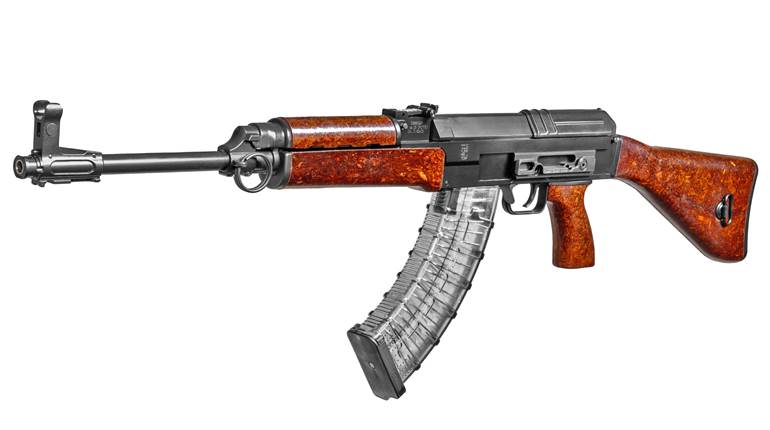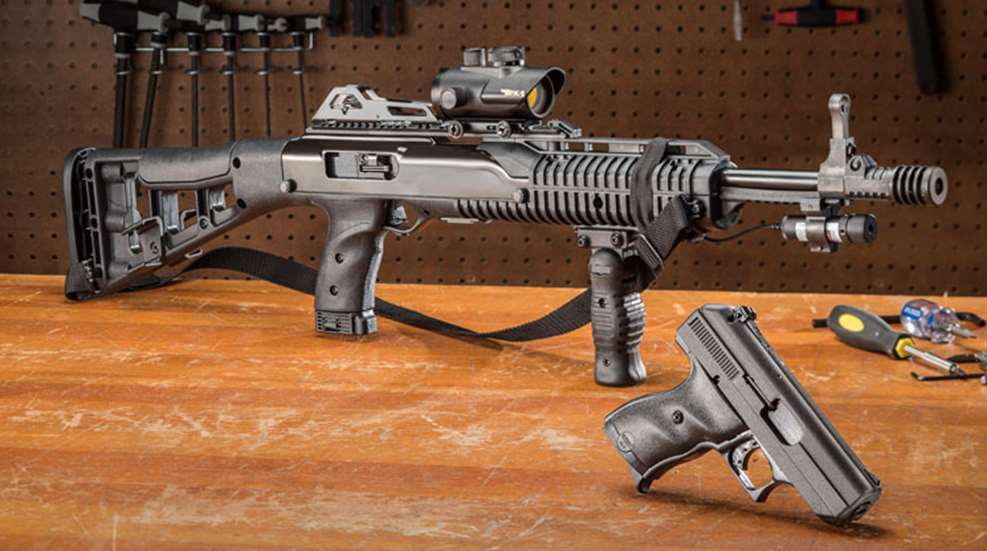
“I’ve had an interest in firearms since … forever. A Ruger Bearcat was one of my first handguns. I also liked High Standard pistols. They shot well—and I could afford the lower-end ones. They were working-people’s guns. That’s the market I’m looking for. I make ‘blue-collar’ guns,” said Deeb, proudly. “Ruger started out that way, making lower-priced guns that were a good product that won’t wear out. That’s hard with semi-autos. That’s why I put a lifetime warranty on mine. I began to think of improvements and finally developed a prototype pistol. I set up my business in 1993 in the current location in Mansfield, Ohio. My first gun was the Model C-9.”
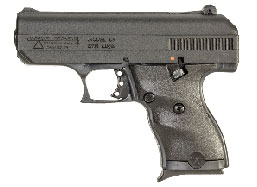
Deeb was born in Mishawaka, near South Bend, in Indiana. The family soon moved to Wabash. “I lived in a working-class neighborhood,” he said. “As a teenager, I wanted independence and a car. I got a job and dropped out of school. To get a better job at Memcor [a maker of military radios in nearby Huntington] I bought an electronics textbook. I’m a quick study and passed their trouble-shooting test. The book was of little practical value—a means to an end. As an honor student, getting my GED was nothing.”
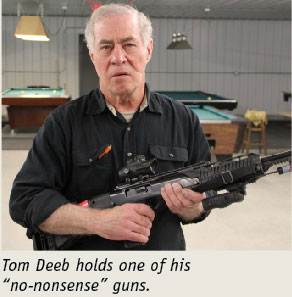
Deeb served in the military from 1972 to 1976, installing and trouble-shooting electronic equipment all over Southeast Asia. After returning, he went into business repairing and rebuilding television sets in Lima, Ohio, and later in Mansfield. It was work, but not what he wanted. In the late 1980s Deeb met a man in the gun business who employed some of Deeb’s ideas. He then developed his own prototypes.
In a field saturated with gunmakers, economy was Deeb’s basis for everything. All Hi-Point guns are semi-automatic and use the simple blowback method of operation. Safety and reliability are achieved by making the slides of the handguns and bolts of the carbines from a heavy, tough zinc-aluminum alloy to give them enough mass to handle the recoil of cartridges from 9 mm Luger to .45 ACP—and all Hi-Point guns are +P rated. The frames were first made of aluminum, but are currently made of high-strength polymers. Economy is achieved by casting the slides and bolts and injection-molding the polymer parts, thus avoiding expensive machining. Barrels are made of seamless 4140 or 4130 steel tubing made to Deeb’s specifications and ordered 25,000 to 100,000 ft. at a time. Barrels are cut and button-rifled individually. Since their introduction, finishes have been improved through powder-coating and baked-on compounds. Savings, achieved by these design techniques, allow such features as three-dot, fully adjustable sights and last-round hold-opens. And all Hi-Point guns come with a lifetime warranty. Four models are currently available based on chambering: .380 ACP, 9 mm Luger, .40 S&W and .45 ACP. Hi-Point magazines are interchangeable between the carbines and pistols.

In 1996, the first carbine was added to the line. The current models (TS) have a newly designed stock and are available in .380 ACP, 9 mm Luger, .40 S&W and .45 ACP. The .380 ACP version was just introduced this year. The carbines are available with three accessory rails, and feature easier assembly/disassembly and improved ergonomics compared to previous versions. Most notable is the spring-loaded buttplate that reduces muzzle rise by absorbing recoil.
“I make guns that fit me,” explained Deeb. “They also seem to fit everyone else. Ergonomics are very important. A few years ago, when my vision began to get a little worse, I came up with a ghost-ring sight for the pistols that made a big improvement in my shooting, so I offered it as a free accessory. Interestingly, about 30 to 35 percent of the pistols sold use it.”
There is currently a staff of 55 employees, that Deeb likens to a big family. Mike Strassell is the chief engineer, and supervisors, one of whom programs the CNC machines, oversee production crews for the .40- and .45-cal. carbines, the 9 mm carbines, 9 mm and .380 pistols, and .40 and .45 pistols, respectively.
Total production so far is about 2 million guns, and annual output is 185,000. According to the National Shooting Sports Foundation, Hi-Point currently ranks among the top 10 U.S. firearm manufacturers.
When I asked Deeb about the company name, he told me, “The name came to me one day driving down the road. I was thinking about how much fun I was having doing this stuff, saw a furniture truck from High Point, North Carolina, and considered names in the industry—Aim-Point, Hi-Power—and came up with Hi-Point and went for it.”
Deeb became fascinated with the science of forensic firearm examination, which is how, as an examiner, I met him. “I included design elements in my guns to be of specific use to the forensic community, beginning in 1994,” said Deeb. “We now start with a particular number for each model of pistol. Rifles start with letters that are easily identifiable.” Beyond this, Deeb uses uncommon rifling patterns and makes breech faces that leave readily identifiable markings on fired cartridge cases. He began doing workshops for firearm examiners at the Ass’n of Firearm and Tool Mark Examiners (AFTE) annual training seminar and became a Technical Advisor to AFTE in 2002. Currently, he conducts about 20 tours of his plant a year for firearm examiners.
Deeb will be 65 years old this year and is planning to retire. When asked about future developments he indicated that Strassell’s Machine, Inc., is buying the company. “We’ve discussed a lot of things. We aren’t going to make rimfires or shotguns,” said Deeb. “The line will be much the same. I love this business and I’ll certainly be around to consult.”
When shotgun maker Ansley Fox was criticized for introducing a “hardware store” model his response was: “Not a cheap gun, but a good gun cheap.” That same slogan could certainly apply to Hi-Point firearms.
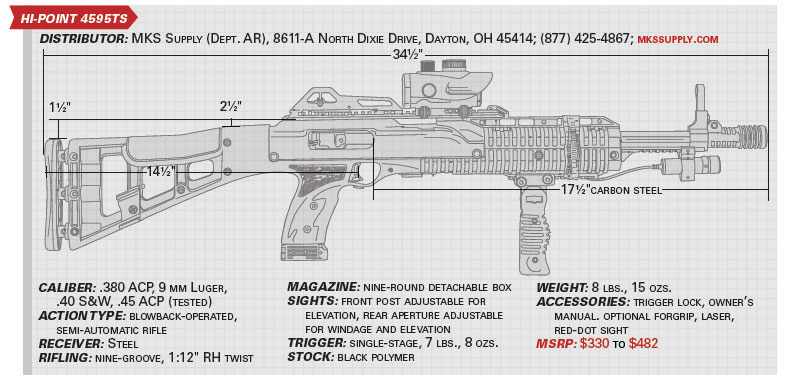
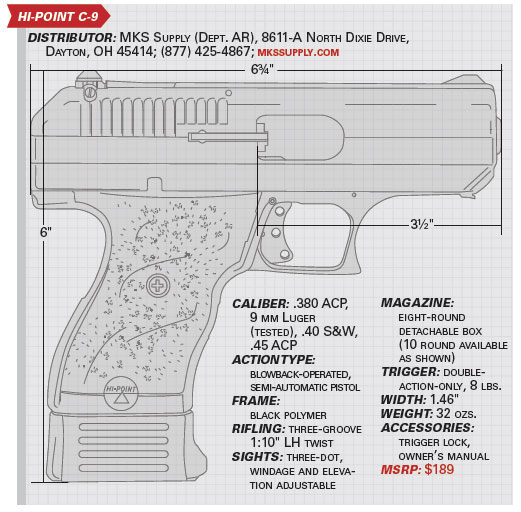
Shooting The Hi-Point 4595TS Carbine & C-9 Pistol
The carbine I tested was tricked out with a compensator, folding front grip, BSA red-dot sight, Beam Shot laser and two spare magazines that are clipped to the stock. At a length of 34½" with a 17½" barrel, the test carbine (with accessories and loaded magazines) weighed in at 10 lbs., 6 ozs. Magazine capacity is 10 rounds, and the design features a last-round hold-open. The manual safety is on the left side. There is also a magazine disconnect safety. It is a hefty, but compact gun. The trigger breaks at 7 lbs., 8 ozs. The take-up is minimal with a rather crisp let off. In addition to some Cor Bon HP ammunition, my shooting partner for the afternoon —Roger Weir—brought a supply of cast-bullet, semi-wadcutter handloads to the Huntington (W.Va.) Rifle and Pistol club range.
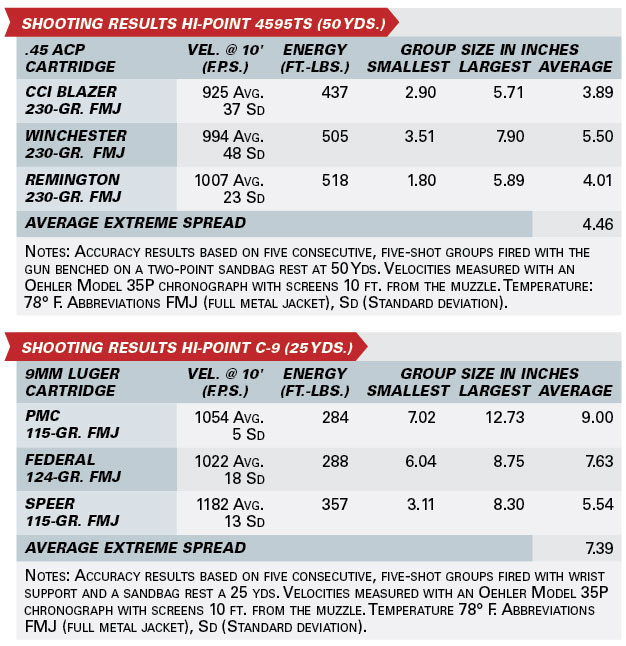
In shooting the carbine, the first thing I noticed was the positive effect of the compensator and particularly the spring-loaded buttplate. Recoil was a modest straight-back bump. That allowed keeping the target acquired with minimal disturbance. A 3" bullseye stayed well centered in the scope at 30 yds. during rapid fire. At this range we could produce fast-fire groups 4" and under. This drew immediate comparison to a much heavier Thompson SMG that climbed off target after the third shot. This certainly qualified the carbine as a very capable tactical/self-defense arm. According to Deeb, the .45 version is less accurate than the 9 mm or .40 S&W. Accuracy testing was at 50 yds. on the author’s farm range in Ohio. The carbine was fired with Remington, Winchester and CCI Blazer (aluminum cased) ammunition.
Function firing of the C-9 was done by my brother, who made the following observations. The C-9 comes with a click-adjustable rear sight, and an extra ghost-ring sight was included. The sight features two red dots rear and one yellow front. The barrel is 3½". At the breech is a chamber observation port allowing easy visual confirmation of a round in the chamber. Overall weight is 32 ozs. Magazine capacity is eight rounds, although a 10-round-capacity magazine is available. Two magazines are included. The magazine release is on the left grip as is the safety, and both are easy to find. As with the carbine, there is a magazine disconnect safety and last round hold-open. The trigger on my sample had an 8-lb. break with moderate take up and a fairly crisp release. The stocks are finger-scalloped on the sides with a grip extension on the magazine. The shooter described the grip as “comfortable” with a good balance. The weight of the pistol absorbs much of the recoil.
I tested the gun outdoors at 25 yds. with PMC, Federal and Speer ammunition.
In shooting the carbine, there were unexpected misses (with the Winchester ammunition) that went off the target. “Mulligans” were taken which landed on target. The cause came to light in collecting fired brass, which yielded four split cases.
My brother did not care for the two-red, one yellow dot on the pistol’s sights, preferring three white dots. In adjusting the rear sight, he complained that screw adjustments were not marked for direction but soon discovered that by looking through the slot underneath he could see the gap increase and decrease. Change was also observable in moving the sight for windage.
In all, we fired more than 200 rounds through each test gun. Both the carbine and pistol functioned flawlessly—not a hitch even with some defective ammunition. Deeb mentioned that firing lead-bullet handloads in the carbine would result in some barrel leading, adding that a few shots with jacketed ammunition would clear it out. I found that to be true.













